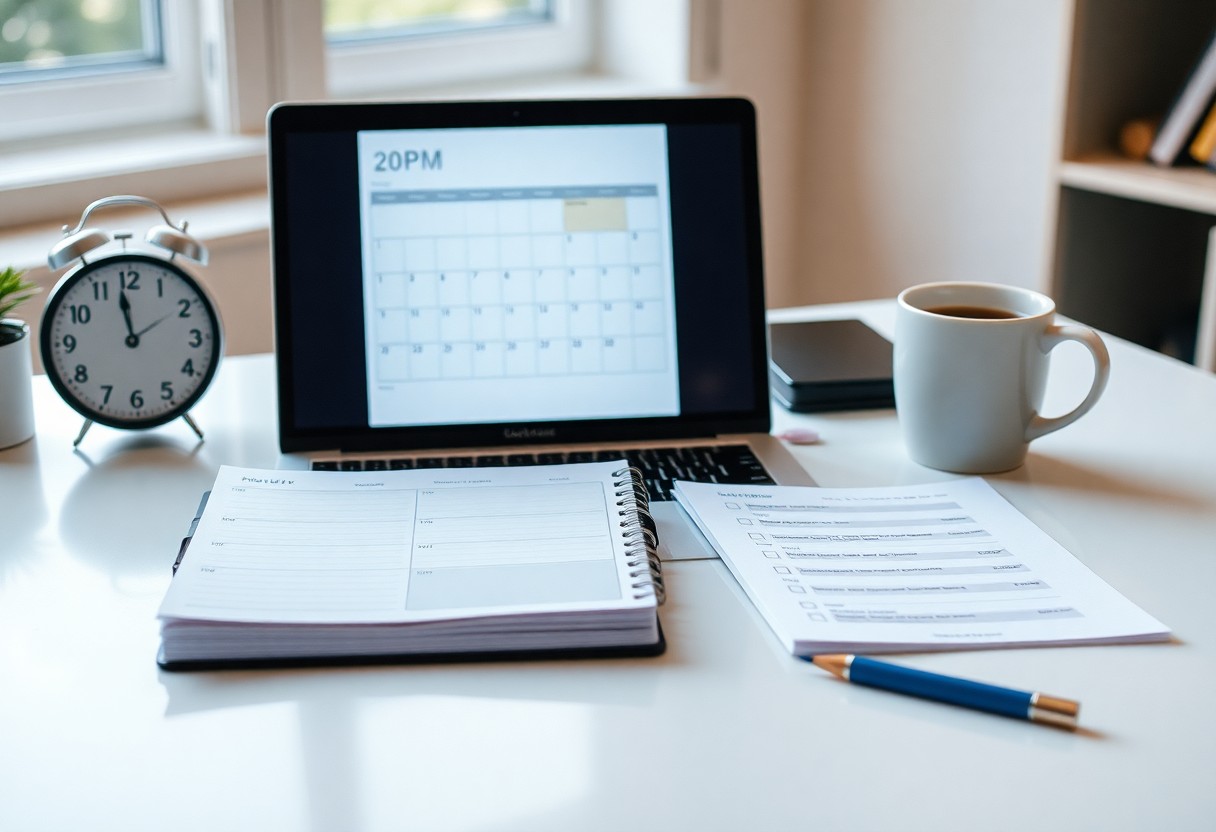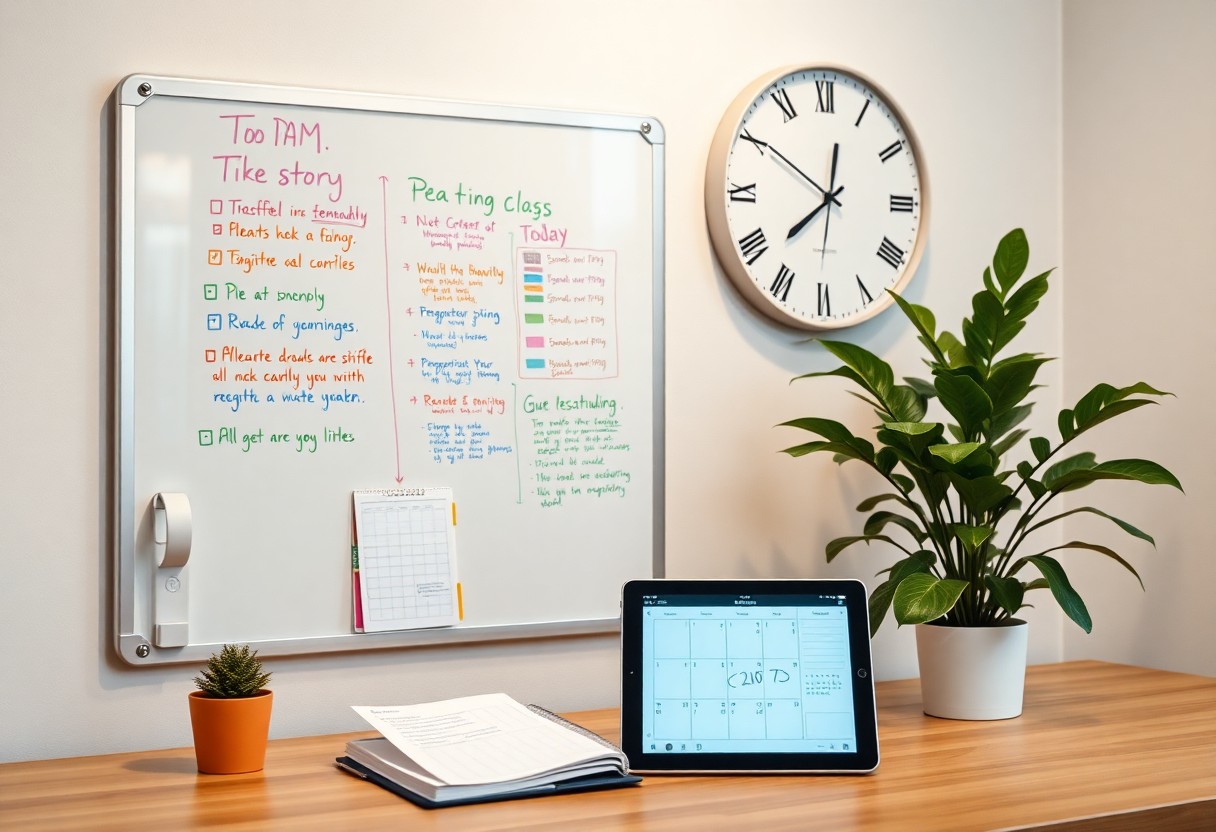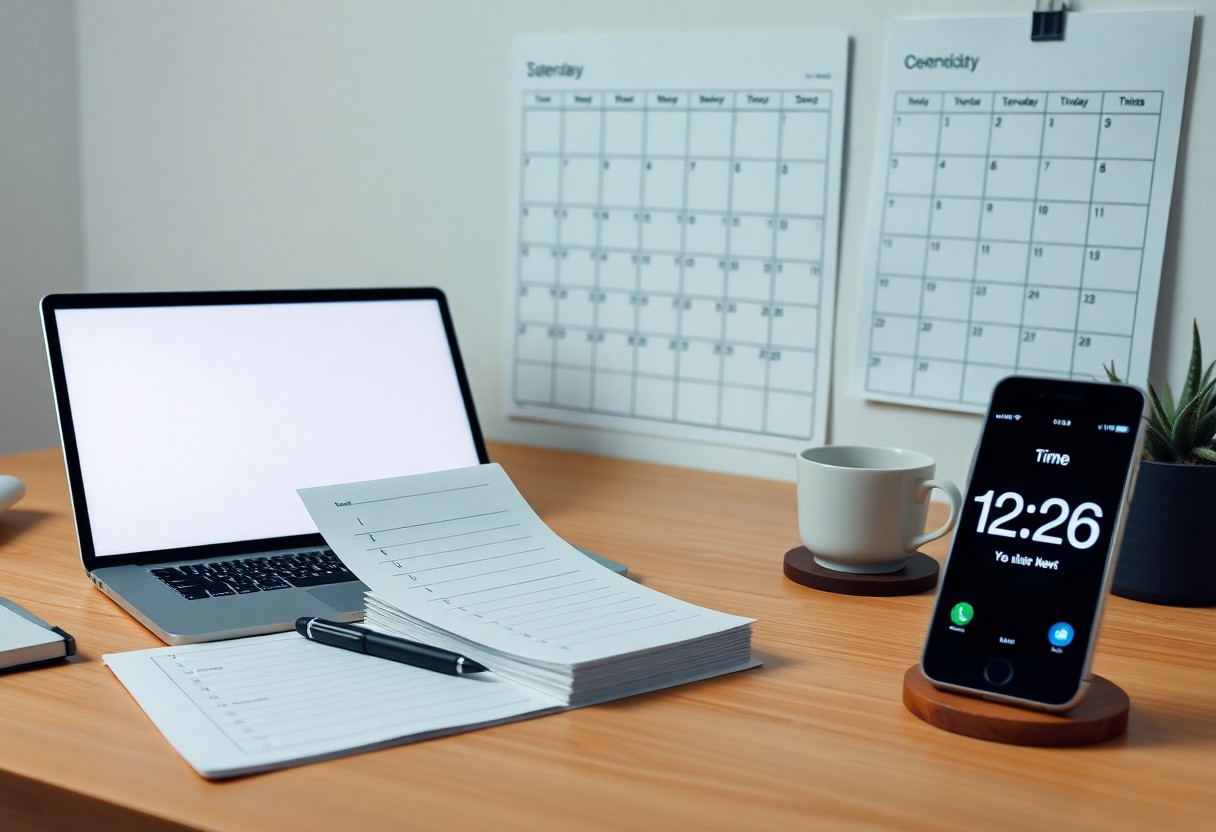Most professionals struggle to balance their workloads and personal lives, often leading to late hours and increased stress. By adopting effective daily planning habits, you can boost productivity and achieve a sense of control over your tasks. Techniques such as prioritizing tasks, setting specific time blocks, and minimizing distractions are vital to help you complete your work efficiently. Embracing these habits not only allows you to finish work early but also enhances your overall job satisfaction.
Key Takeaways:
- Set clear and specific goals for the day.
- Prioritize tasks using a system like the Eisenhower Matrix.
- Break tasks into smaller, manageable chunks.
- Utilize time-blocking methods to allocate focused work periods.
- Limit distractions by creating a dedicated workspace.
- Review daily achievements and adjust plans as needed.
- Incorporate regular breaks to maintain productivity levels.
Understanding Daily Planning
Daily planning transforms chaotic workloads into manageable tasks. By structuring your day, you enhance productivity and reduce stress, allowing you to focus on what’s truly important. A clear outline of daily objectives not only streamlines workflows but also keeps you motivated to tackle challenges with confidence.
The Importance of Goal Setting
Establishing specific, measurable goals directs your daily activities and provides a sense of purpose. By defining what you aim to achieve, you create a roadmap for your workday. This clarity leads to improved focus and can significantly increase your overall output.
Prioritizing Tasks Effectively
Focusing on the right tasks at the right time encourages efficiency. Utilize systems like the Eisenhower Matrix to categorize tasks by urgency and importance, ensuring you allocate your energy where it matters most. Examine deadlines, potential impact, and resources needed to determine which tasks deserve immediate attention.
Effective prioritization involves recognizing tasks that align with your goals and contribute significantly to your projects. Begin by listing everything you need to accomplish, then assess the urgency and importance of each item. For example, a pressing client deadline takes precedence over minor administrative duties. By addressing high-impact tasks first, you advance your work significantly, freeing up time for less critical responsibilities later in the day.
Time Management Techniques
Effective time management techniques can dramatically enhance your work efficiency and help you finish tasks ahead of schedule. By adopting structured methods to tackle your daily responsibilities, you can minimize distractions, streamline processes, and allocate time effectively, leading to a more productive workday.
The Pomodoro Technique
The Pomodoro Technique divides your work into 25-minute focused intervals, known as “Pomodoros,” followed by short breaks. This method promotes sustained concentration while allowing you to recharge frequently. After completing four Pomodoros, a longer break enables you to refresh your mind, effectively preventing burnout and maintaining high productivity levels throughout the day.
Time Blocking Method
Time blocking involves scheduling specific blocks of time for distinct tasks or categories of work. By allocating dedicated periods to work on specific projects, you enhance focus and clarity, reducing the likelihood of multitasking distractions. This structured approach helps you remain on track, ensuring that imperative tasks receive the attention they deserve.
To implement the Time Blocking Method effectively, categorize your tasks and assign them to specific time slots in your calendar. For example, you might designate mornings for creative work, afternoons for meetings, and late afternoons for administrative tasks. This method encourages discipline in adhering to your schedule and creates a visual roadmap for your day. By adhering to these blocks, you can significantly reduce decision fatigue and increase the chances of completing your work ahead of time.

Tools and Resources for Planning
Effective daily planning requires the right tools and resources. Selecting a system that complements your workflow can enhance productivity and ensure you complete tasks efficiently. You can choose from a range of digital applications and analog methods, each offering unique advantages tailored to your preferences. Experimenting with different options will help you discover what best supports your objectives and styles.
Digital Tools for Daily Planning
Digital tools for planning allow for real-time updates and easy access across devices. Apps like Todoist, Trello, and Notion enable you to create, organize, and prioritize your tasks effortlessly. Utilizing features such as reminders, deadlines, and collaboration options can significantly streamline your workflow, keeping you accountable and on track.
Analog Methods: Planners and Journals
Analog methods, such as planners and journals, offer a tactile approach to daily planning. Many professionals find that writing down tasks helps reinforce memory and commitment. Dedicated daily planners are often structured to allocate time and prioritize goals, while journals can foster reflective practices that clarify your objectives and enhance productivity.
Using planners and journals can transform your daily routine. For instance, the Panda Planner combines daily, weekly, and monthly layouts designed to enhance productivity and promote gratitude. Bullet journals allow for customization, enabling you to design a page layout that suits your unique planning style. According to a 2021 study, individuals using analog methods reported a 27% increase in goal achievement compared to those relying solely on digital tools. By incorporating these analog methods into your planning routine, you can promote focus and clarity, driving you to achieve your daily objectives.
Building a Routine
A consistent routine anchors your day, enabling you to harness productivity and finish work early. By establishing rituals that structure your day, you optimize focus and efficiency. Emphasizing routines minimizes decision fatigue, allowing you to spend energy on more important tasks. Daily habits create momentum, helping you navigate your responsibilities with ease and clarity.
Morning Planning Rituals
Your mornings set the stage for the day ahead. Dedicate a few minutes to outline your priorities, focusing on the top three tasks you must accomplish. This focused approach not only outlines your goals but also energizes you to tackle them with intention. Incorporate a quick review of your calendar to align commitments and deadlines, ensuring a smoother workflow.
Evening Reflection Practices
Every evening, take time to reflect on your day. Consider what you achieved, what fell short, and how you can improve tomorrow. This practice enhances self-awareness and provides valuable insights. By analyzing your productivity, you’re better positioned to adjust your strategies for the next day, ensuring continuous improvement.
Evening reflection should involve a structured approach, such as journaling your accomplishments and challenges. Spend about 10 to 15 minutes reviewing your tasks; identify what worked well and what didn’t. This practice can include rating your productivity and noting any distractions that arose. By consistently analyzing these factors, you create a feedback loop that encourages personal growth and strategic adjustments, preparing you for more effective days ahead.

Overcoming Procrastination
Procrastination often derails productivity and hampers your ability to finish work early. Recognizing and addressing this tendency is vital for enhancing your work habits. Identifying specific reasons behind your procrastination can help you implement targeted strategies that keep you on track and engaged with your tasks.
Identifying Triggers
Understanding what prompts your procrastination is the first step towards overcoming it. Common triggers include feelings of overwhelm, lack of interest, or fear of failure. By maintaining a journal or a simple list of tasks that you tend to delay, you can pinpoint patterns. Analyzing these entries will reveal specific tasks or situations that invoke procrastination, enabling you to craft personalized strategies to combat them.
Strategies to Stay Focused
Staying focused requires intentional strategies tailored to your work style and environment. Break tasks into smaller, manageable parts to avoid feeling overwhelmed. Utilize techniques like the Pomodoro Technique, where you work for 25 minutes followed by a 5-minute break, enhancing your concentration. Setting specific goals with deadlines also helps create a sense of urgency that can drive you toward prompt completion.
Implementing these strategies involves understanding the value of time management. For example, research shows that using the Pomodoro Technique can increase productivity by as much as 25%. Pairing short bursts of focused work with scheduled breaks allows your brain to recharge, preventing burnout while maintaining high levels of concentration. Additionally, establishing a clear workspace, free from distractions, sets the stage for productive work sessions. Energizing your focus through techniques such as these not only boosts your output, but fosters a proactive mindset against procrastination.

Measuring Productivity
Measuring productivity provides you with tangible insights into your work habits and helps identify areas for improvement. Tracking your output against set goals not only reveals your efficiency but also encourages accountability. Utilize tools like time-tracking apps to analyze how much time you allocate to tasks, and assess whether you’re meeting your daily, weekly, and monthly targets. Establishing a clear measurement system allows you to pivot strategies as needed, ensuring you consistently work towards finishing your tasks ahead of schedule.
Setting KPIs for Personal Performance
Setting Key Performance Indicators (KPIs) establishes a benchmark for your productivity. Define specific, measurable, achievable, relevant, and time-bound (SMART) goals that align with your daily responsibilities. For instance, aim to complete a certain number of projects weekly or reduce time spent on routine tasks by a percentage. These clear objectives not only guide your focus but also foster a sense of accomplishment as you achieve them.
Regularly Reviewing Progress
Regularly reviewing your progress helps you stay aligned with your productivity goals. Schedule weekly or monthly assessments to evaluate how well you’re meeting the KPIs you’ve set. Examine both successes and areas where you fell short, allowing for adjustments in your approach. This reflective practice can reveal patterns that help you optimize your workflow, ensuring you continually enhance your output.
During these reviews, take the time to gather data on completed projects, time spent on each task, and overall satisfaction with your work. Tools like spreadsheets or productivity software can assist in clearly visualizing this data. Engaging in this process enables you to pinpoint not only areas needing attention but also your most productive periods. For instance, you may notice that specific tasks take longer than anticipated, prompting a reevaluation of your methods or suggesting the implementation of new strategies. By continually reassessing your performance, you maintain momentum towards achieving your goal of finishing work early.
To wrap up
With these considerations, you can enhance your daily planning habits to finish work early. Prioritize your tasks each day, focusing on the most important ones first. Utilize time-blocking to allocate specific hours for each task, minimizing distractions and increasing productivity. Set clear, achievable goals for your work sessions, and take regular breaks to reset your focus. By streamlining your planning and maintaining discipline, you can create a more efficient workday and enjoy the benefits of finishing ahead of schedule.
FAQ
Q: What is the importance of setting priorities in daily planning?
A: Setting priorities helps professionals focus on high-impact tasks that contribute most to their goals. By identifying what needs to be done first, they can allocate their time and energy more effectively.
Q: How can breaking tasks into smaller steps improve efficiency?
A: Breaking tasks into smaller, manageable steps makes them less overwhelming. This allows for quicker completion of each part, leading to a sense of accomplishment and progress throughout the day.
Q: What role does time blocking play in effective daily planning?
A: Time blocking involves scheduling specific blocks of time for each task. This technique minimizes distractions and helps professionals stay focused on one task at a time, enhancing productivity.
Q: Why is it beneficial to limit daily tasks to a manageable number?
A: Limiting daily tasks allows professionals to concentrate their efforts and avoid feeling overwhelmed. Focusing on a few key tasks increases the chances of finishing work early.
Q: How does reviewing the previous day’s accomplishments aid in planning?
A: Reviewing the previous day helps professionals assess what was achieved and what needs to be carried forward. This reflection ensures better planning by adjusting strategies for increased efficiency.
Q: What techniques can be used to minimize distractions during work hours?
A: Techniques such as turning off non-important notifications, designating a quiet workspace, and using apps that block distractions can significantly enhance focus and productivity.
Q: How can setting a specific end time for work improve daily planning?
A: Setting a specific end time motivates professionals to complete tasks efficiently, as they work with a clear deadline in mind. This practice encourages better time management and reduces procrastination.
